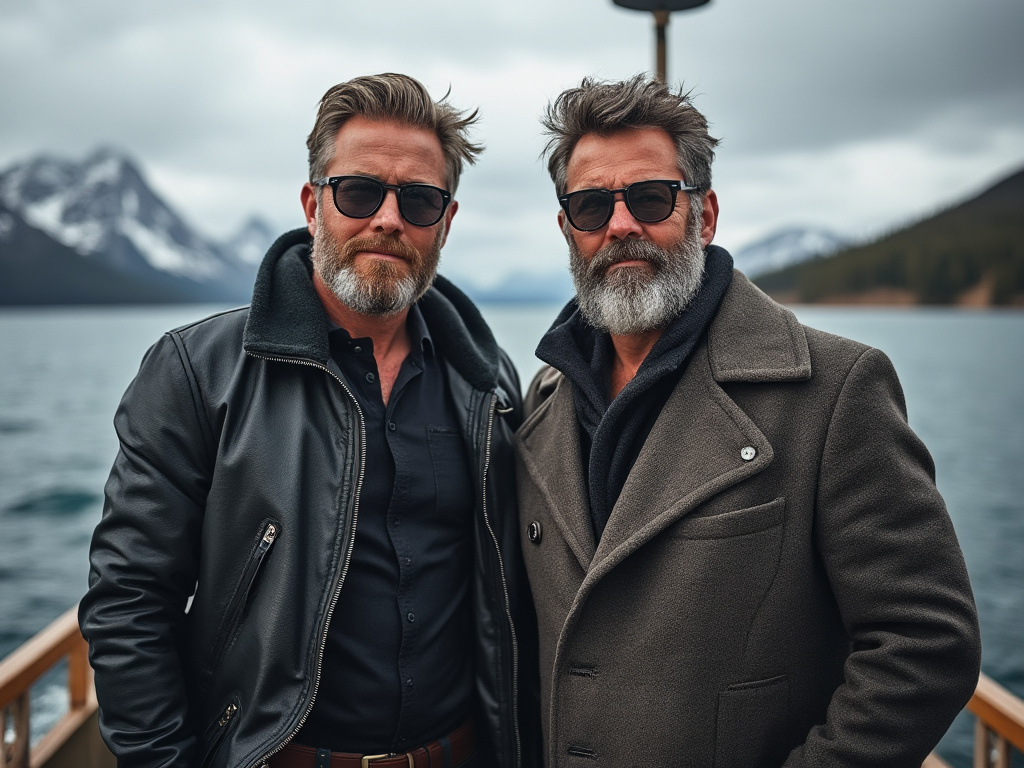
Nano Billionaires
Redefining success one tiny fortune at a time—meet the Nanobillionaires who prove that small ideas can yield massive returns.

Introducing the Nanobillionaire Brothers: Titans of Tiny Fortunes
In a world where bigger often means better, Thomas and John—better known as the Nanobillionaire Brothers—are living proof that small is indeed mighty. These two prodigies have taken the business world by storm, not by amassing vast empires of wealth in the traditional sense, but by perfecting the art of making a fortune out of the most minuscule opportunities. Their journey from the sun-drenched shores of California to the rugged coastlines of Maine, and eventually into the corners of Ohio and Texas, is as unconventional as their business acumen.
Let’s start at the beginning. The brothers were born in a picturesque beach town in California, where they spent their early years playing in the sand and soaking in the sunshine. It was here that their keen sense of observation was first nurtured. While other kids were building sandcastles, Thomas and John were selling seashells to tourists, marking up the price tenfold. Even at a young age, they realized the power of taking something ordinary and adding a twist of ingenuity to turn a profit. However, the idyllic Californian lifestyle was soon traded for the colder, harsher environment of Maine, where their father, an ambitious but often misguided entrepreneur, decided to relocate the family in pursuit of his latest venture—a lobster roll food truck that, despite his enthusiasm, failed spectacularly.
Maine was a far cry from the sun-kissed beaches of their childhood, but it was here that the brothers honed their skills in the art of business. Their father’s string of failed ventures served as a cautionary tale, and the brothers vowed to succeed where he had not. Thomas, the younger by three years, was the more analytical of the two, with a penchant for numbers and a fascination with efficiency. He spent hours dissecting his father’s failures, identifying where things went wrong and what could have been done differently. John, on the other hand, was the more charismatic and adventurous, always ready to take risks that others would shy away from. Together, they were a formidable team, complementing each other’s strengths and covering for each other’s weaknesses.
Their first joint venture in Maine was selling firewood to their neighbors. But this wasn’t just any firewood. The brothers painstakingly selected the finest pieces, ensuring each log was perfectly seasoned and ready to burn. They then bundled the wood with handmade kindling and delivered it in neatly stacked piles. Their customers were willing to pay a premium for the convenience and quality, and soon enough, the brothers had a thriving business on their hands. But they didn’t stop there. Next came a line of artisanal maple syrup, which they sold at the local farmer’s market. Again, their attention to detail and commitment to quality set them apart, and the syrup quickly became a local favorite.
By the time Thomas reached early adulthood, it was clear that the brothers were destined for something greater. Thomas, always the more introspective of the two, decided to strike out on his own, heading to Ohio in search of new opportunities. John, ever the adventurous spirit, set his sights on Texas, where the wide-open spaces and booming economy promised endless possibilities. And so, with a tearful goodbye, the brothers parted ways, each determined to make their mark on the world.
John: The Lone Star of Lone-Star Enterprises

John rocked the nation by making waves in Texas, a state that perfectly suited his larger-than-life personality. From the moment he arrived, it was clear that John was destined for greatness. Texas, with its booming economy, wide-open spaces, and a culture that celebrates boldness and innovation, was the perfect playground for someone with John’s entrepreneurial spirit. Where others saw obstacles, John saw opportunities, and he wasted no time in seizing them.
John’s first venture in Texas was a line of designer dustpans. It sounds ridiculous, but that’s exactly what made it a success. John understood that in a world where people are increasingly obsessed with aesthetics and design, even the most mundane household items could be transformed into luxury products. His dustpans, made from high-quality materials and available in a variety of stylish designs, quickly became a must-have item for trendy homeowners. The dustpans were soon followed by matching brooms, dusters, and other cleaning supplies, all of which were marketed as luxury items for the discerning consumer.
But John’s success wasn’t just about selling fancy dustpans. He had a knack for spotting trends before they hit the mainstream, and he wasn’t afraid to take risks on products that others might have dismissed as too niche or too unconventional. One of his most successful ventures was a line of luxury pet rocks, which he sold as part of a broader trend towards minimalism and simplicity in home decor. The rocks, which came in a variety of shapes, sizes, and colors, were a hit with consumers who appreciated their quirky charm and the fact that they required no maintenance. John’s ability to turn something as simple as a rock into a highly profitable business is a testament to his creativity and his willingness to think outside the box.
But it wasn’t just John’s products that set him apart—it was also his approach to business. John understood that in a state like Texas, where everything is bigger and bolder, it wasn’t enough to simply offer good products. You had to create an experience. And that’s exactly what John did. His stores, known as Lone-Star Enterprises, were designed to be more than just places to shop—they were destinations. Each store was meticulously designed to reflect the unique character of the surrounding area, with an emphasis on local culture, history, and traditions. The result was a shopping experience that was both immersive and unforgettable, one that kept customers coming back again and again.
John’s path to becoming a nanobillionaire was as wild and unpredictable as the state he calls home. He took risks that others wouldn’t dare, and he wasn’t afraid to fail. But through it all, he remained true to his vision, never losing sight of what had made him successful in the first place: a willingness to embrace the unconventional and a determination to make the most out of even the smallest opportunities. Today, John is a household name in Texas, known not just for his business acumen, but also for his larger-than-life personality and his unwavering commitment to his customers.
Thomas: The Quiet Conqueror of the Midwest

Thomas’s journey to becoming a nanobillionaire began in Ohio, a state that, to most, seemed as ordinary as they come. But to Thomas, Ohio was a blank canvas, a place where he could build something truly unique. While others might have been drawn to the larger cities or more glamorous industries, Thomas saw potential in the overlooked and the mundane. He quickly identified a niche market that was ripe for disruption: biodegradable toothpicks.
It might sound absurd at first—after all, how much money could there possibly be in toothpicks? But Thomas knew better. He recognized that the growing trend towards sustainability and eco-friendliness was more than just a fad. People were becoming increasingly conscious of their environmental impact, and they were willing to pay a premium for products that aligned with their values. Thomas’s biodegradable toothpicks were a hit, and before long, they were being stocked in upscale grocery stores and boutique shops across the country.
But Thomas didn’t stop there. He began expanding his product line to include other everyday items, each with a unique twist that set them apart from the competition. There were artisanal lint removers made from recycled materials, eco-friendly dental floss that doubled as garden twine, and even a line of sustainable shoe polish made from organic beeswax. Each product was carefully crafted and meticulously marketed, with an emphasis on quality and sustainability. Thomas’s attention to detail and commitment to his principles paid off, and soon enough, he had built a small but mighty empire in the heart of the Midwest.
Thomas’s success was not without its challenges. The market for niche, eco-friendly products was competitive, and there were plenty of larger companies with deeper pockets vying for the same customers. But Thomas’s ability to stay one step ahead of the competition, combined with his relentless drive and unwavering focus, allowed him to thrive where others faltered. His path to becoming a nanobillionaire was paved with countless late nights, tough decisions, and a willingness to take risks that others would shy away from. But through it all, Thomas remained true to his vision, never losing sight of what had brought him success in the first place: a commitment to quality, innovation, and sustainability.
Today, Thomas is widely regarded as one of the most successful entrepreneurs in the Midwest, though he would be the first to downplay his achievements. Soft-spoken and reserved, Thomas prefers to let his work speak for itself. He shuns the spotlight, content to focus on his business and his family. But those who know him best understand that his quiet demeanor masks a fierce determination and an unyielding commitment to excellence. He may not seek out the limelight, but there’s no denying that Thomas has left an indelible mark on the business world, one that will be felt for generations to come.
Small But Mighty

Together, the Nanobillionaire Brothers have redefined what it means to be successful in a world obsessed with big numbers. Their journeys, though divergent, share a common thread: a belief in the power of small, seemingly insignificant opportunities. Whether it’s biodegradable toothpicks or designer dustpans, the brothers have proven that you don’t need to be a billionaire to make a billion-dollar impact—just a few hundred million and a lot of creativity.
Their story is a testament to the power of thinking small, staying humble, and never underestimating the value of a good laugh. In a world where size matters, the Nanobillionaire Brothers remind us that sometimes, it’s the tiniest fortunes that make the biggest difference. They may not have the fame or the fortune of a typical billionaire, but in their own unique way, they’ve achieved a level of success that is truly unparalleled. And in the end, that’s what really matters. After all, in the grand scheme of things, it’s not about how much money you have—it’s about what you do with it. And the Nanobillionaire Brothers have done more with less than anyone could have ever imagined.